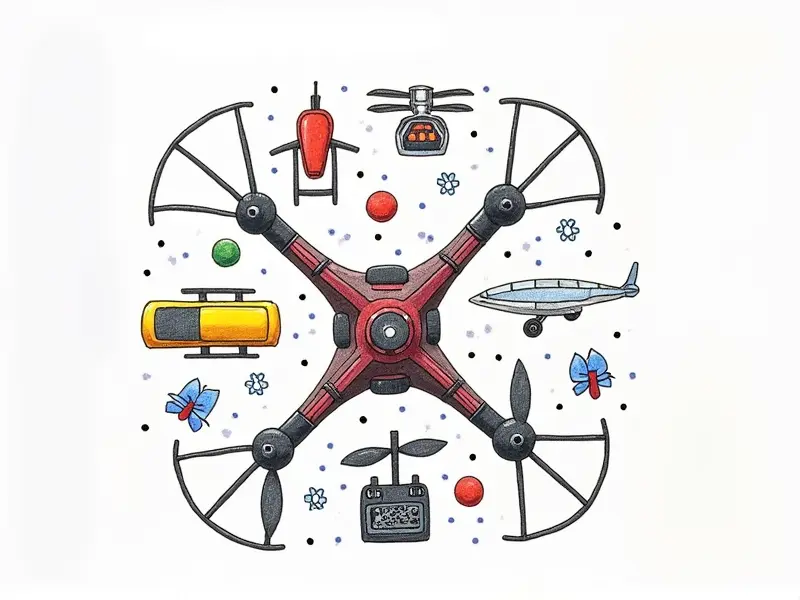How to stabilize an RC drone?

Top Tips for Stabilizing Your RC Drone
Stabilizing your RC drone is crucial for achieving smooth and controlled flights. Whether you're a beginner or an experienced pilot, mastering the art of stability can significantly enhance your flying experience. In this article, we'll explore various techniques to ensure that your RC drone performs flawlessly in all conditions.
Mastering Drone Stability: Quick Guide
To stabilize your RC drone effectively, start by understanding its basic components and how they interact with each other. This includes the frame, motors, propellers, and flight controller. Adjusting these elements can greatly impact stability:
- Frame Design: Opt for a well-balanced frame that distributes weight evenly.
- Motors and Propellers: Ensure all motors are functioning optimally and use propellers of the same quality and size.
- Flight Controller Settings: Fine-tune parameters like PIDs (Proportional, Integral, Derivative) for better control.
Secrets to Perfect Drone Balance
Achieving perfect balance in your RC drone involves several key factors. Start by checking the center of gravity (CG). A well-balanced CG ensures that the drone remains stable during maneuvers:
- Weigh Components: Use a scale to measure and adjust the weight distribution.
- Battery Placement: Position batteries strategically for optimal balance.
- Cargo Management: Keep additional equipment or cargo centered on the frame.
Achieve Smooth Flights with RC Drones
To achieve smooth flights, focus on optimizing your drone's performance through regular maintenance and calibration. This includes:
- Motors and Propellers: Regularly inspect motors for wear and tear.
- Sensors Calibration: Calibrate sensors to ensure accurate readings.
- Firmware Updates: Keep your flight controller firmware up-to-date for the latest features and bug fixes.
Essential Tricks for Stable RC Flight
Here are some essential tricks that can help you achieve stable flights:
- Tune PID Values: Adjust PIDs to match your flying style and drone's performance characteristics.
- Use a GPS Module: Adding a GPS module enhances stability by providing accurate position data.
- Implement Wind Compensation: Use wind sensors or software algorithms to counteract gusts and turbulence.
Instantly Improve Drone Stability Now
If you're looking for quick fixes, consider these immediate actions:
- Battery Check: Ensure all batteries are fully charged and of the same quality.
- Mechanical Adjustments: Tighten loose screws and ensure all parts are securely fastened.
- Software Updates: Install any available software updates for your flight controller.
No More Shaky Flights: Stabilize Now
To eliminate shaky flights, focus on these critical steps:
- Check Frame Alignment: Ensure the frame is perfectly square and all arms are parallel.
- Adjust Propeller Pitch: Fine-tune propeller pitch for optimal lift and stability.
- Optimize Flight Controller Settings: Customize settings to match your flying environment and conditions.
Ultimate Guide to Drone Flight Control
The ultimate guide to drone flight control involves understanding the intricacies of each component and how they work together. This includes:
- Firmware Customization: Modify firmware settings for better performance.
- Sensor Integration: Integrate additional sensors like barometers, accelerometers, and gyroscopes.
- Flight Mode Selection: Choose the right flight mode based on your flying conditions and objectives.
Easy Fixes for Unstable RC Drones
If you're experiencing instability in your RC drone, try these easy fixes:
- Battery Swap: Replace old or low-quality batteries with high-performance ones.
- Mechanical Inspection: Conduct a thorough inspection for any loose parts or wear and tear.
- Firmware Update: Install the latest firmware updates to address stability issues.
Top Tips for Stable FPV Racing Drones
For FPV racing drones, stability is even more critical due to high speeds and aggressive maneuvers. Consider these tips:
- Fine-Tune PIDs: Optimize PID values specifically for racing conditions.
- Battery Management: Use lightweight batteries with consistent discharge rates.
- Racing Mode Settings: Configure your flight controller to maximize speed and agility while maintaining stability.
Boosting Stability in RC Airplanes Instantly
To boost the stability of RC airplanes, focus on these quick tips:
- Balance Wing Load: Distribute weight evenly across the wings for optimal lift and control.
- Motor Adjustments: Fine-tune motor power settings to match your flying style.
- Sensor Calibration: Regularly calibrate sensors to ensure accurate flight data.
Conclusion
Stabilizing your RC drone is essential for achieving smooth, controlled flights. By understanding the key components and implementing the tips outlined in this guide, you can significantly enhance your drone's stability. Whether you're a beginner or an experienced pilot, mastering these techniques will elevate your flying experience to new heights.

